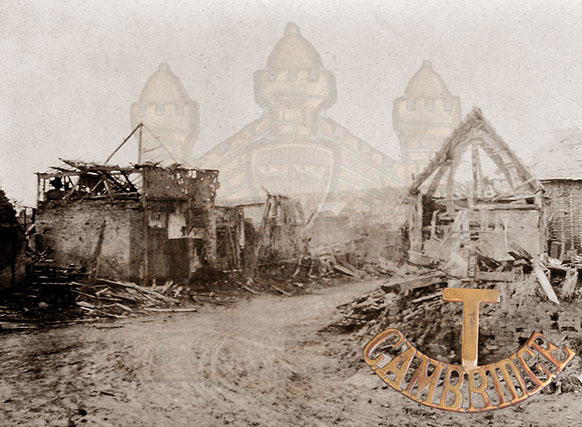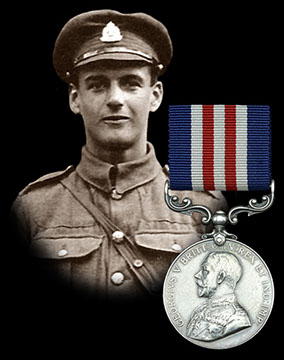
Who Were
The Cambs
The Cambs
at War
1/1st Btn 1914-1919
1914 - 1/1st Overview
1915 - 1/1st Overview
1915 - St Eloi
1915 - Fosse Wood
1916 - 1/1st Overview
1916 - The Schwaben
1916 - St Pierre Divion
1917 - 1/1st Overview
1917 - St Julien
Insignia, Medals & Books
Remembering The Cambs
Biographies
About Us &
This Site
Morlancourt - 8th to 9th August 1918
After being on the defensive since March 1918 as the Germans mounted a series of offensives in a bid to win the war, the British Army had weathered the storm and was preparing its reply. The massive assault astride the River Somme would be launched on August 8th by Fourth Army against the increasingly war-weary Germans.
Preparations for this major offensive had been going on in secret for many months with basis of the plan being to attack objectives, capture them and move on to the next, with points of resistance taken by envelopment tactics. On the night of August 7-8th, the troops of III Corps (12th, 18th and 58th Divisions) were in the Ancre Valley in front of Ville Sur Ancre, Morlancourt and Sailly Lorette. To their right, south of the River Somme, were the Australian Corps.
The resulting battle of August 8th would be dubbed the “blackest day” of the war for the German army as it was forced into retreat that would end in November with the Allied victory.
The 1/1st Cambridgeshires, part of 12th Division, were initially planned to be in reserve for the attack and the Battalion moved forward to the Ballarat and Bendigo Lines, facing the village of Morlancourt. However after a last minute change in the plan the Cambridgeshires were told they would now be taking part in the initial assault, leaving Lt-Col Edward Saint DSO, commanding the Battalion, little time for planning and reconnaissance. Although the Germans were unaware of the impending attack, they had engaged in persistent mustard gas shelling of the Ancre valley. At 12.30am on August 8th, A and B Companies, who were to make the assault, moved into what was known as Burke Line, with C and D in support in Clare Reserve and Copper Trench.
The 12th Division’s action was subsidiary to the main assault on the Morlancourt Ridge by 18th and 58th Division, but no less important. Its attack, carried out by 35th Brigade from 6.20am produced an advance of almost 1,000 yards towards Morlancourt, with half of the 1/1st Cambs on the right (adjacent to 18th Division) advancing with 7th Norfolk and 9th Essex on the left.
By 7am Capt Harry Baynes-Smith, commanding B Coy, reported that his Coy's objective had been taken and patrols had been sent forward, but Lt Ted Hay, commanding A Coy, said his men had failed to reach their objective. A German counter attack on the Cambridgeshires, and German machine guns were thwarting the 35th Brigade’s advance. The two companies sustained about 160 casualties and were pushed back to their front line.
As a result, at 10.15am, both C and D Coys were ordered forward and attacked at 12.15pm, supported by an effective British artillery bombardment. The attackers charged the German position and captured more than 300 prisoners, 14 machine guns and two medium trench mortars. Capt Hollis and Lt Wallis MC, commanding C and D Coys, were able to report the success of the assault at 12.50pm, with the loss of 23 men. Total casualties among the Cambridgeshires for August 8th were five officers and 183 other ranks, including 18 killed and 141 gassed. An interesting account by a witness to the Cambridgeshires' attack can be found by clicking here, the page also contains details of one of the tanks that fought alongside the Cambs at Morlancourt.
Among those killed were 2nd Lt Brian Cobham, a vicar’s son and former pupil at Repton School, who, while commanding a platoon of A Company, had suddenly come upon a German machine gun post. One report suggests Cobham was killed instantly along with two men being wounded, but his runner later told Cobham’s father that his son had been wounded by a German grenade, captured (along with several men) and shot by a German officer. Later when the position was overrun by the British, the German officer was also shot.
Also killed was 2nd Lt Dudley Twelvetrees, a married man living in Cambridge who worked for Lt-Col Saint’s father’s building firm. His fellow officer, Capt Charles Warren later wrote: He knew he wasn’t going to come out alive, positive, but he was quite calm about it all.
By the end of August 8th, the British were overlooking Morlancourt and the advance would continue the next day with 12th Division tasked with outflanking and taking Morlancourt and pushing further forward. This time, C and D Coys of the Cambridgeshires, assisted an attack by 6th Queen’s Royal West Surrey, 6th Buffs and 6th Royal West Kents of 37th Brigade to clear the village. C Coy on the left would clear the north of the village, while D Coy would take the south. This attack started at 5.30pm, but the three tanks due to support this assault were either knocked out or late. Under an artillery barrage, the men advanced and were met by stiff opposition from German machine guns in the village, as well as trench mortars. These were put out of action by Lewis gun fire and by the gallantry of individuals who charged them and killed the crews. In fact, they took 47 prisoners, 19 machine guns and four trench mortars.
After this, the village was cleared quickly, and by 8pm they were able to withdraw to a sunken road after units of 37th Brigade took over, although two platoons under Lt Alf Jackson had to fill a gap on the right of 6th Buffs and and did not rejoin the Battalion until 5.30am on August 10th. Casualties were slight compared to the previous day with one officer (Lt Donald Rayner, of Cambridge) and one man killed and one officer (2nd Lt Harry Chambers) and 14 other ranks wounded. Chambers, a schoolteacher, would die of his wounds two days later.
There were also gallantry awards for officers and men, including a Bar to the Military Cross for Capt Hollis MC, of C Coy. His citation says:
After two companies of the battalion had failed to capture a very strongly held enemy position, the remaining two companies were ordered to advance. This officer led his company forward with great skill and courage, and reached the objective, capturing a large number of prisoners and seven machine guns. On the following day, while clearing Morlancourt, his company was held up by a machine gun. He with a section, rushed and captured the gun, his gallant action clearing the way for the company’s advance.
One of his NCOs, Sgt Herbert George Kirby MM, a labourer at a timber merchant in Cambridge, was awarded the DCM. His citation links to that of Hollis:
On the morning of the 8th August 1918 west of Morlancourt, he rushed single-handed an enemy machine gun position, killed two of the team and captured the gun and four prisoners, his initiative preventing many casualties to his platoon. Although wounded, he continued to lead his men with utter disregard for his personal safety, inflicting severe losses on the enemy until again severely wounded. He showed a splendid example to all ranks under most trying and difficult circumstances.
There was a Military Cross also for Lt Gerald Hugh Singleton, from Ipswich. His citation states:
This officer on 8th August 1918 captured in conjunction with another platoon over 100 prisoners. He displayed great dash and coolness leading his men under heavy shell and machine gun fire, with great skill and determined courage.
Also awarded the MC was Capt Alf Jackson, who was from South Africa. His citation states:
For conspicuous gallantry and devotion to duty during the attack west of Morlancourt on the 8th August 1918. He led his platoon against a strong enemy position with great dash, gained his objective, and captured over 100 prisoners. In the attack on Morlancourt on the 9th August, 1918, he again showed great skill in handling his platoon, showing complete disregard for danger and was largely responsible for the success of the operation.
The operation on August 9th produced Military Cross awards for an officer and warrant officer of D company, and the award to the latter would become part of regimental folklore. The citation for Capt Bert Wallis, from Hadleigh, Sufoflk, commanding D Company, states:
He led his company forward with the greatest dash, reached the objective, and captured many prisoners and seven machine guns. The success of the attack was largely due to the clever manner in which he manoeuvred his company over a very difficult piece of ground. He did splendid work.
His Company Sergeant Major, would also get the MC. The citation for CSM Harry Betts, a railwayman’s son from March, who already held the DCM and Bar, states:
During the attack at Morlancourt on 9th August 1918, the right flank was held up by a nest of machine guns. This warrant officer immediately went forward alone, and with great gallantry and disregard of danger, killed three and captured 30 of the enemy and four machine guns, thereby clearing the way for his company and disposing of an obstruction which might have upset the whole operation. He did magnificent work.
A number of Military Medals were also awarded to men of the Cambridgeshires for their gallantry on August 8th and 9th.
The capture of the village provided an ideal opportunity for souvenir hunters to collect German equipment. Capt Warren remembered:
By this time the bartering for German automatic pistols and Zeiss glasses had begun and the market value was five francs for an ordinary automatic, 10 francs for a Mauser and anything up to 25 francs for a pair of field glasses. Ammunition for the former items was buckshee!
Several items of German weaponry captured at Morlancourt can now be seen in Wisbech and Fenland Museum, in Wisbech.

Photograph, taken shortly after the Armistice, showing part of the devastated village of Morlancourt captured by the Cambridgeshires on August 9th 1918.

2nd Lt Cobham, killed in action during A Coy's unsuccessful attack on August 8th.

2nd Lt Twelvetrees, previously wounded at St Julien in 1917, was killed August 8th.

Arthur Nobes, from Lowestoft, transferred to the Cambs from 7/Suffolk, he was killed while firing his Lewis gun on August 8th.

CSM Harry Betts, put forward for the Victoria Cross for his bravery on August 9th.

Jack Sutton, from Over, another of the men from 7/Suffolk, was awarded the Military Medal for his actions at Morlancourt.

This site went live on the 14th February 2015 to mark 100 years since the 1/1st Cambs went off to war.
WE WILL REMEMBER THEM
Email us: cambsregt@gmail.com
Copyright 2015, 2016, 2017, 2018, 2019 by Felix Jackson. The information and images on this site should not be reproduced without prior permission.